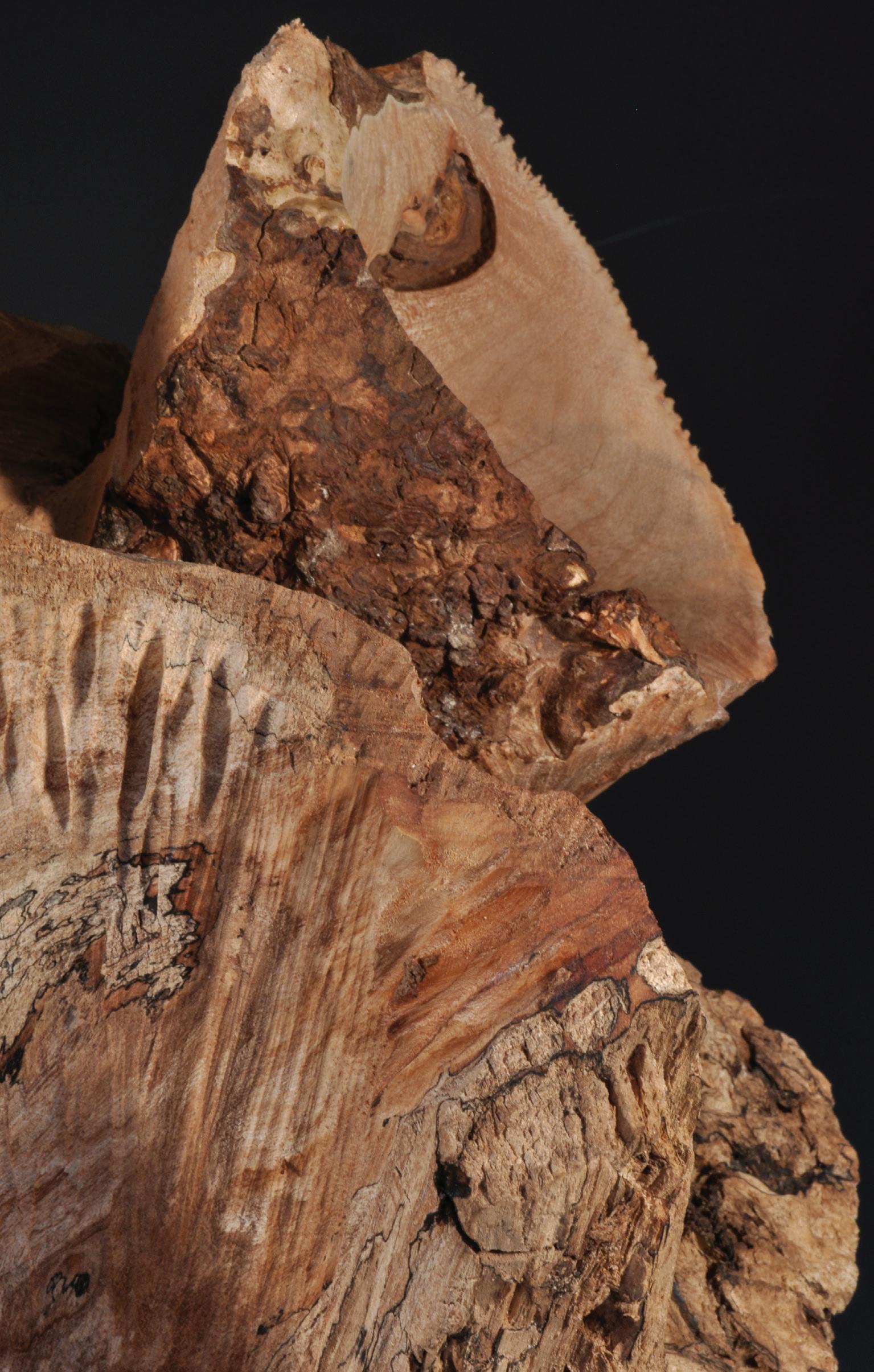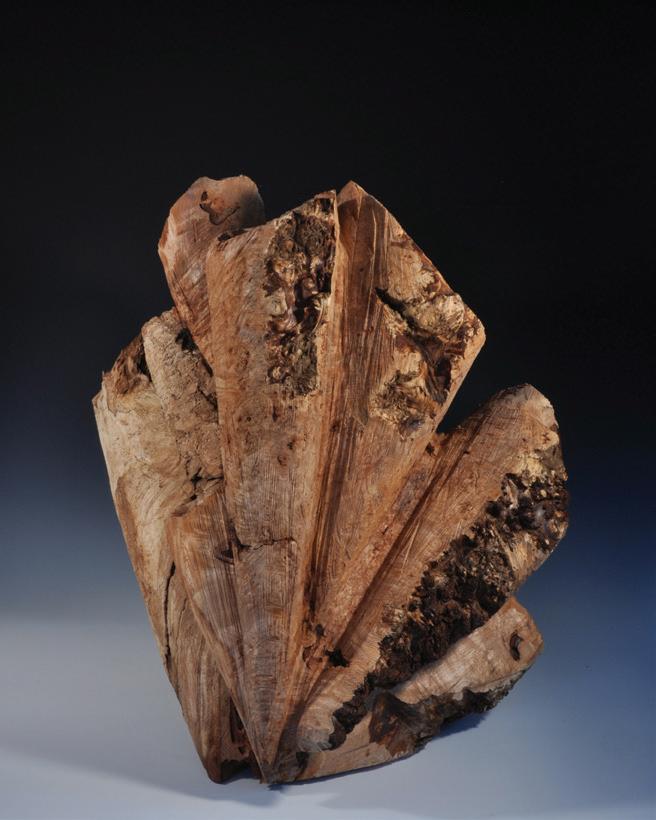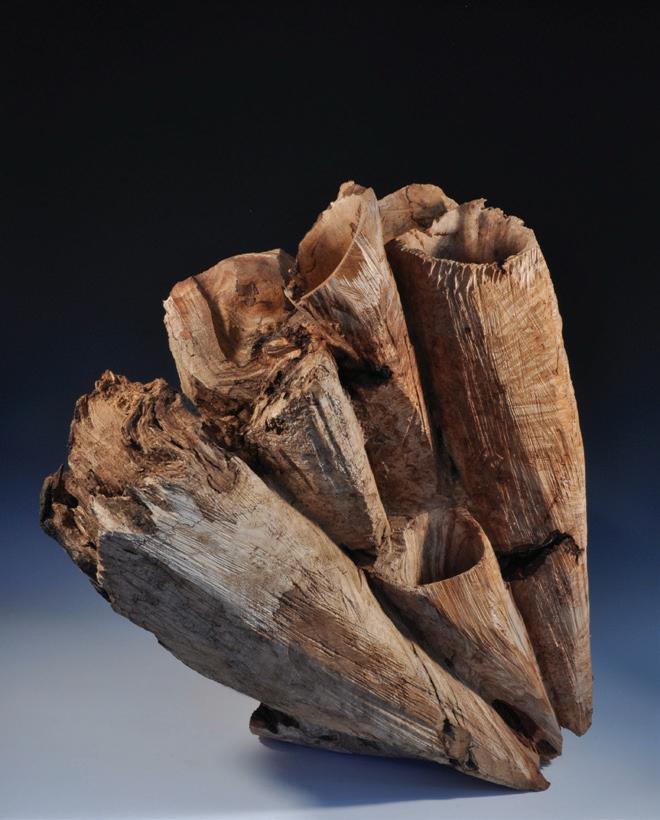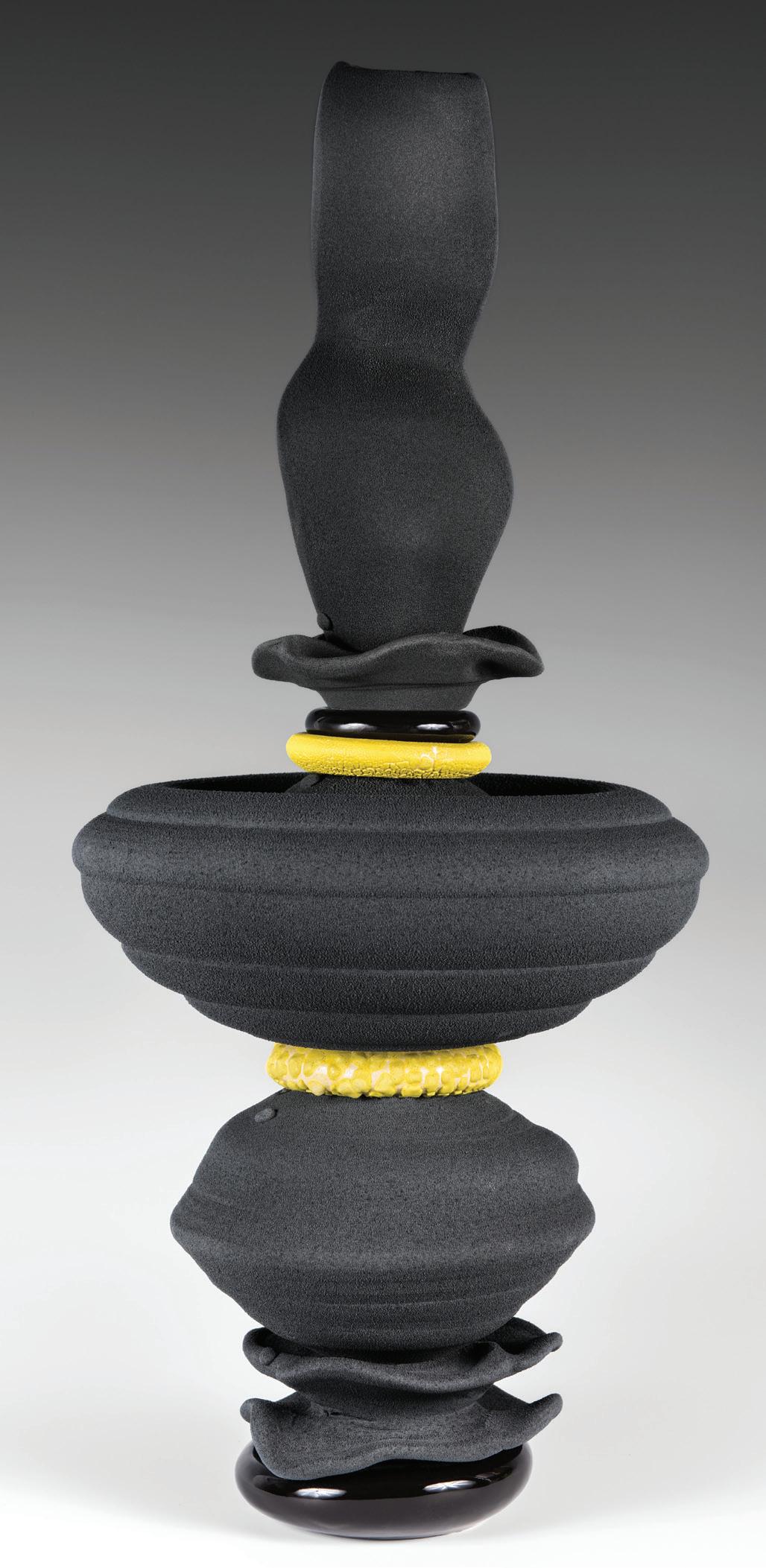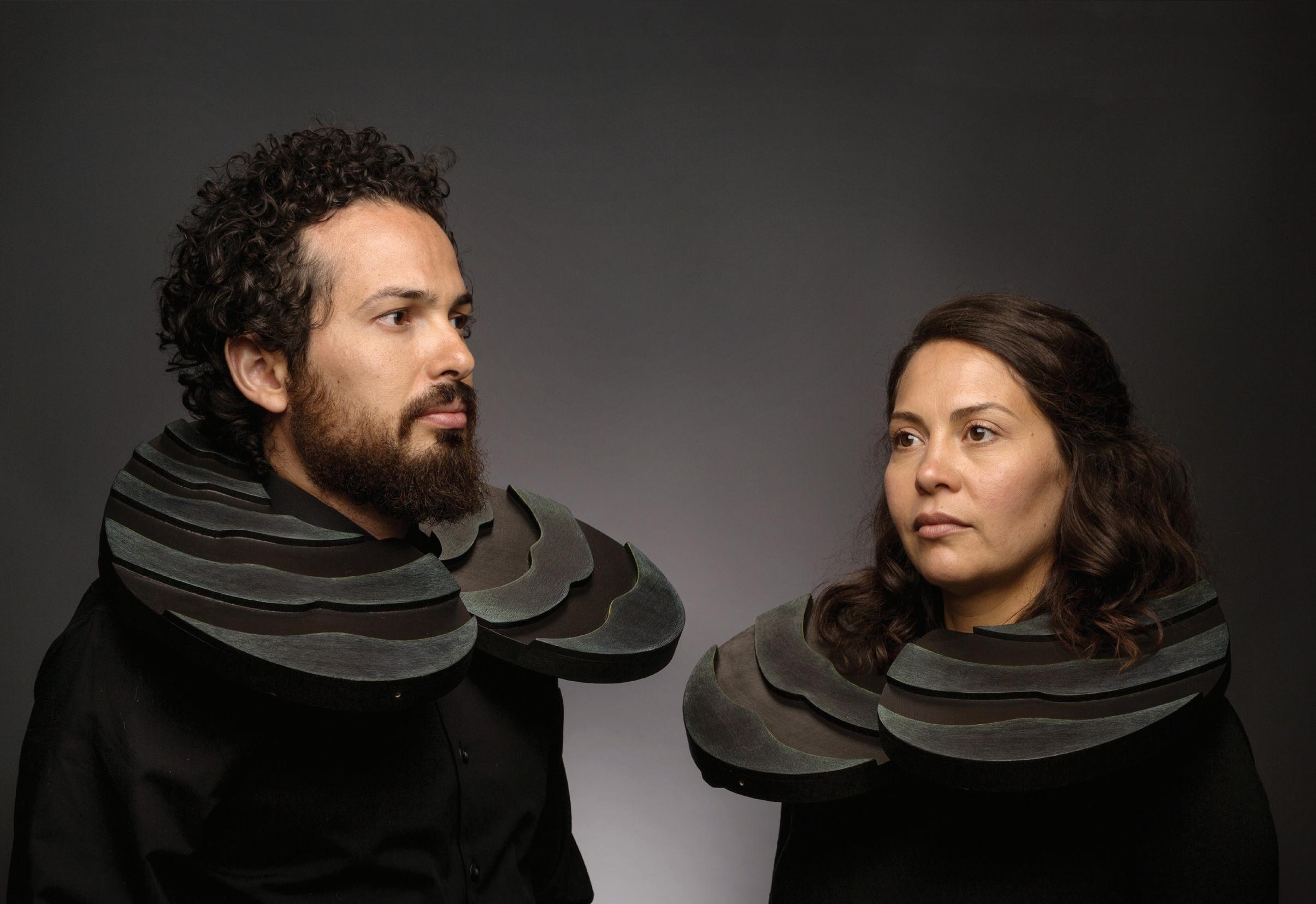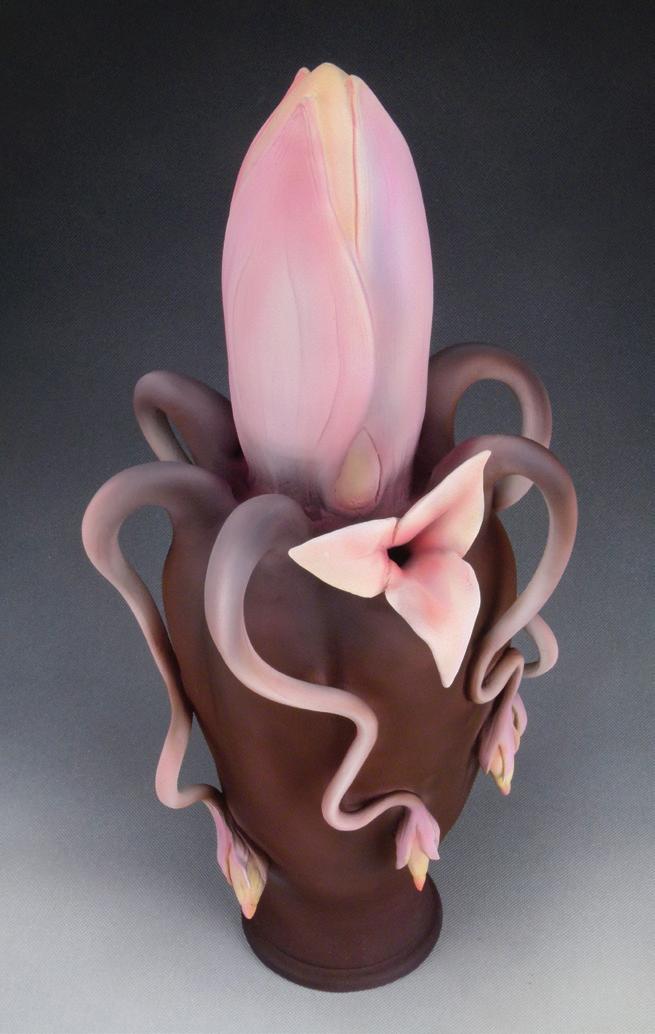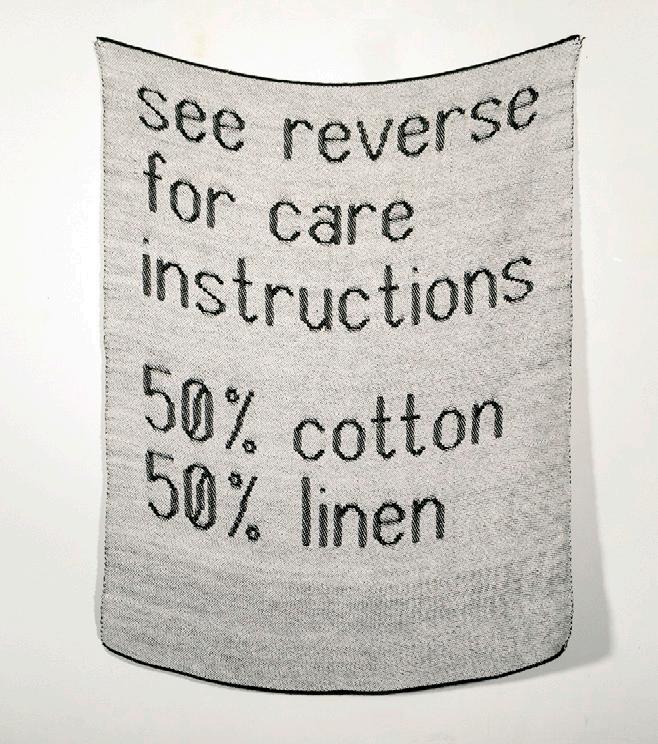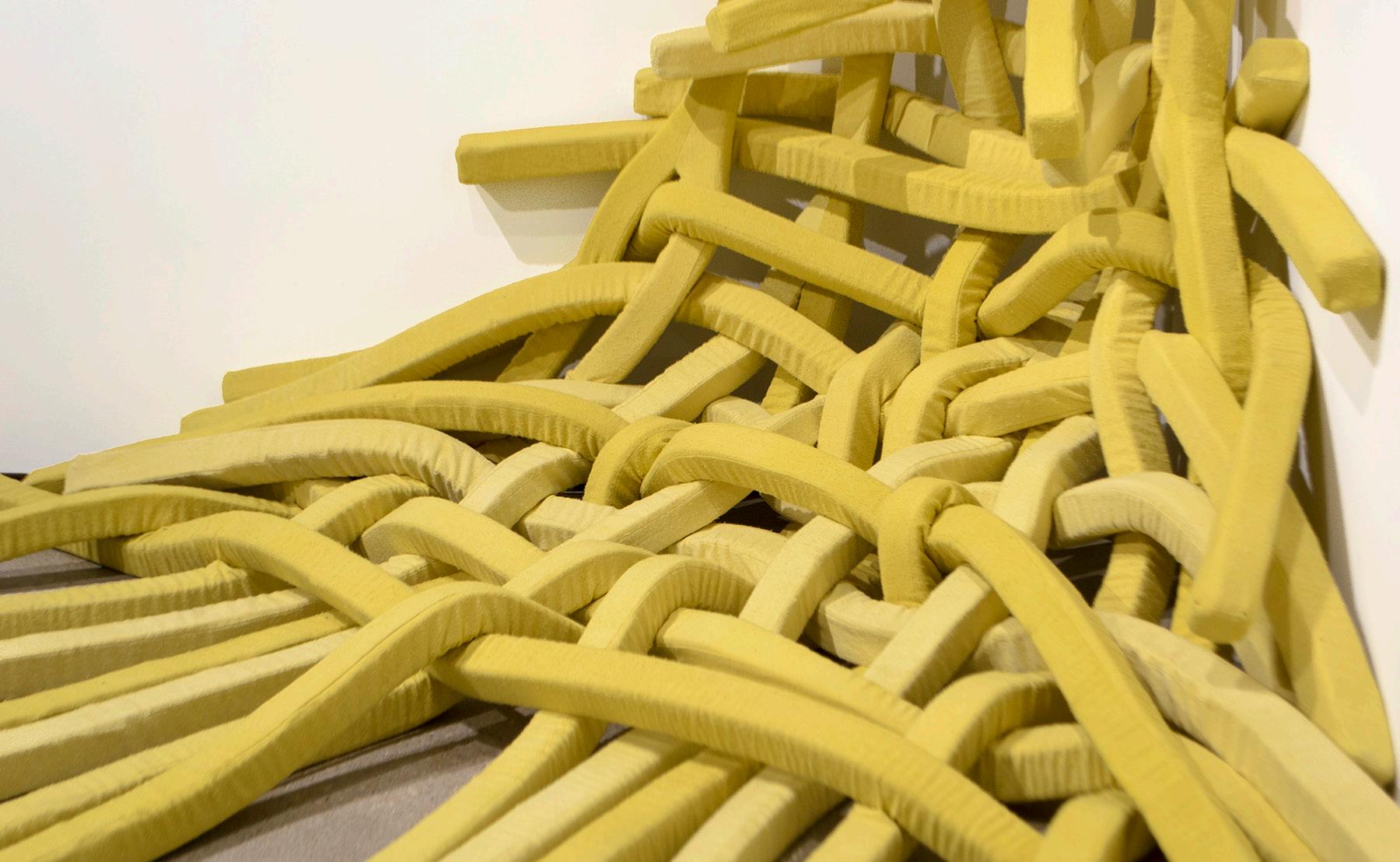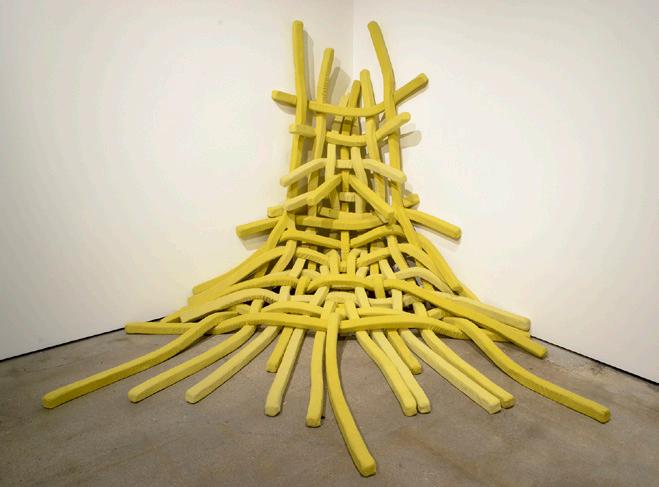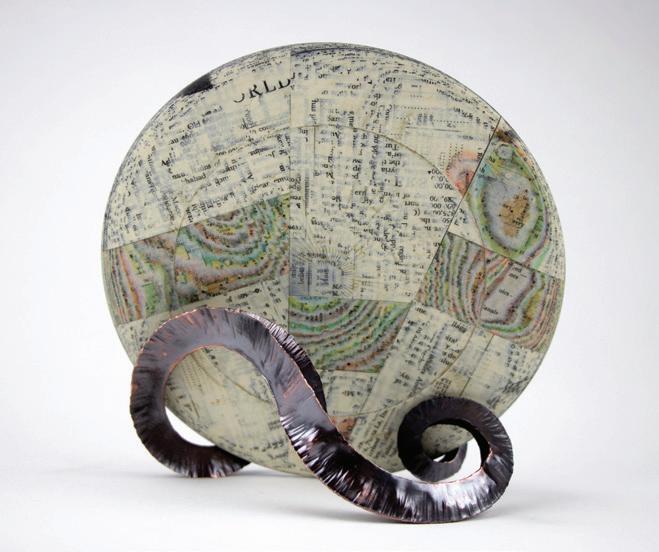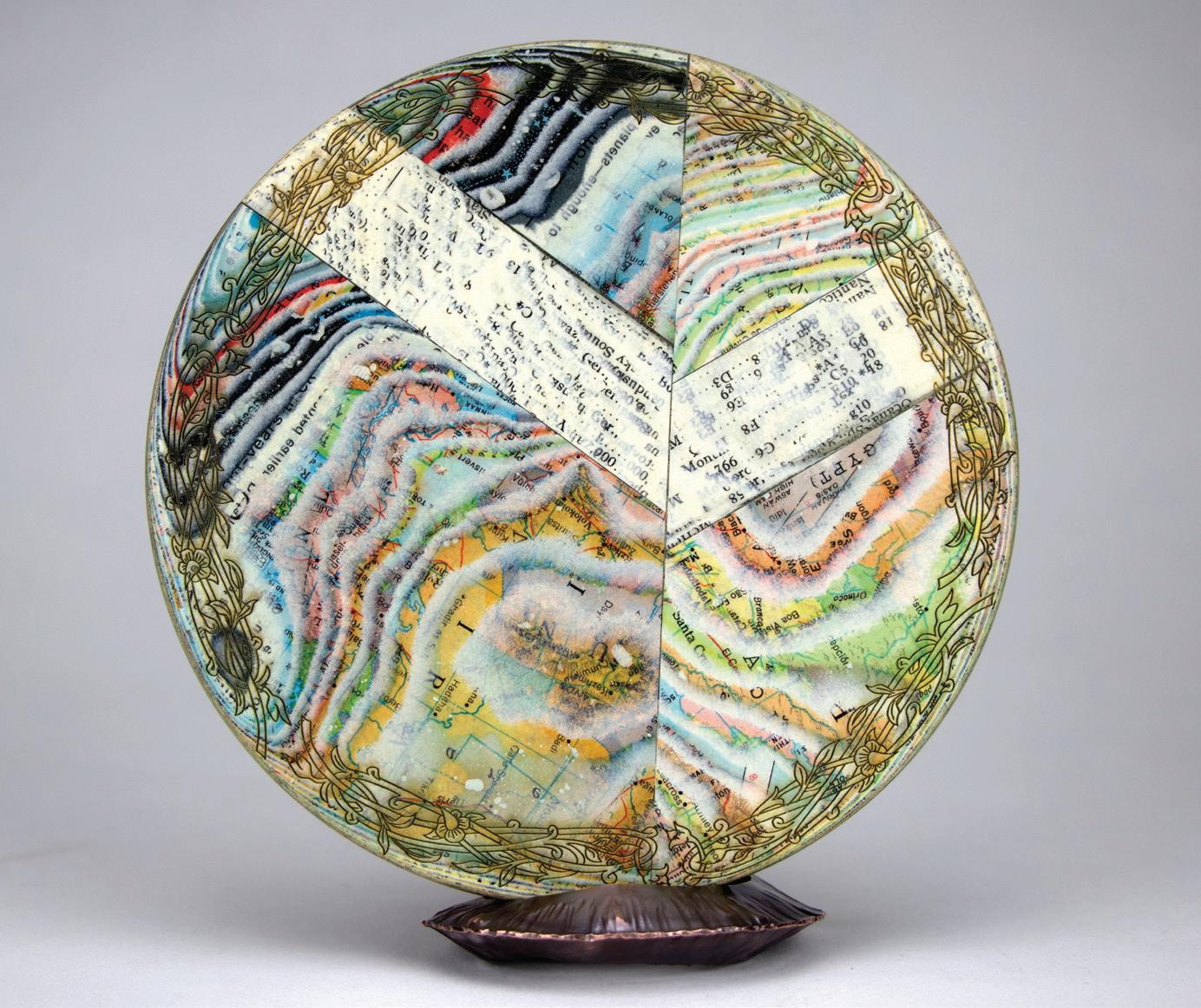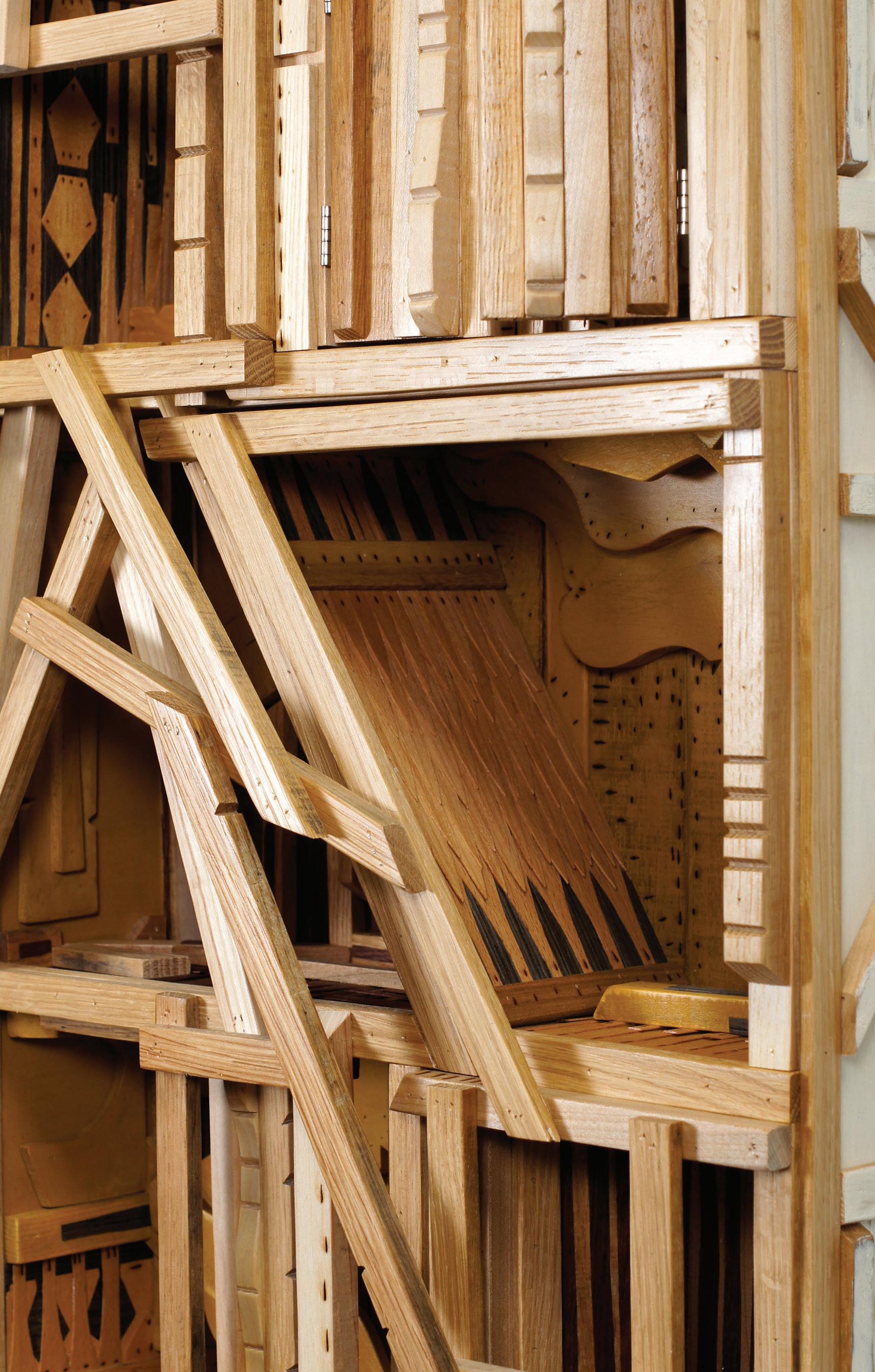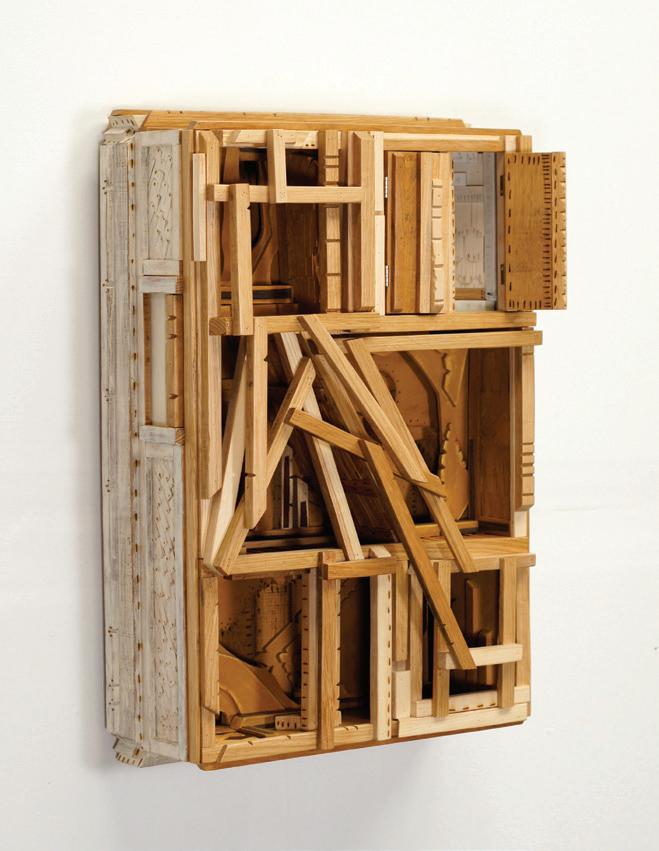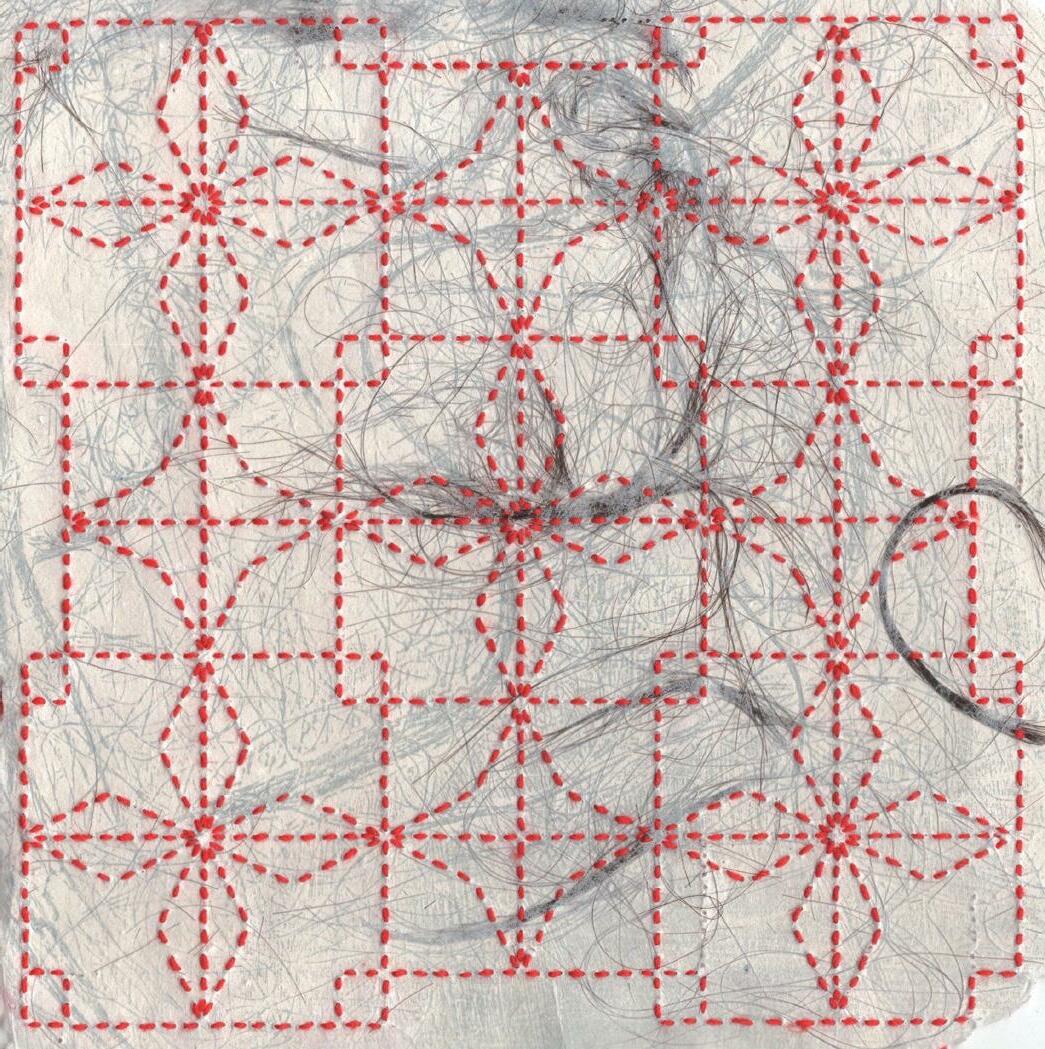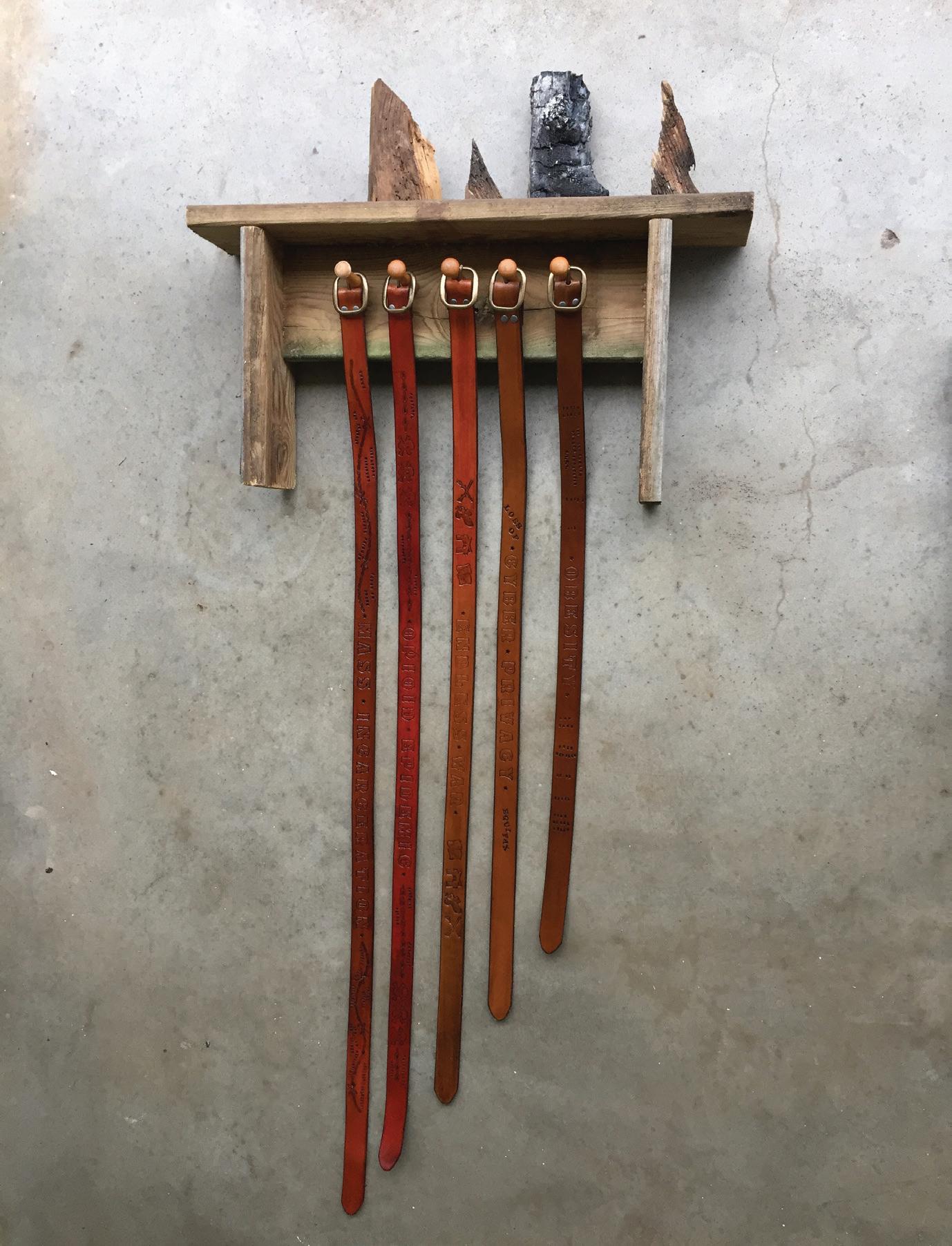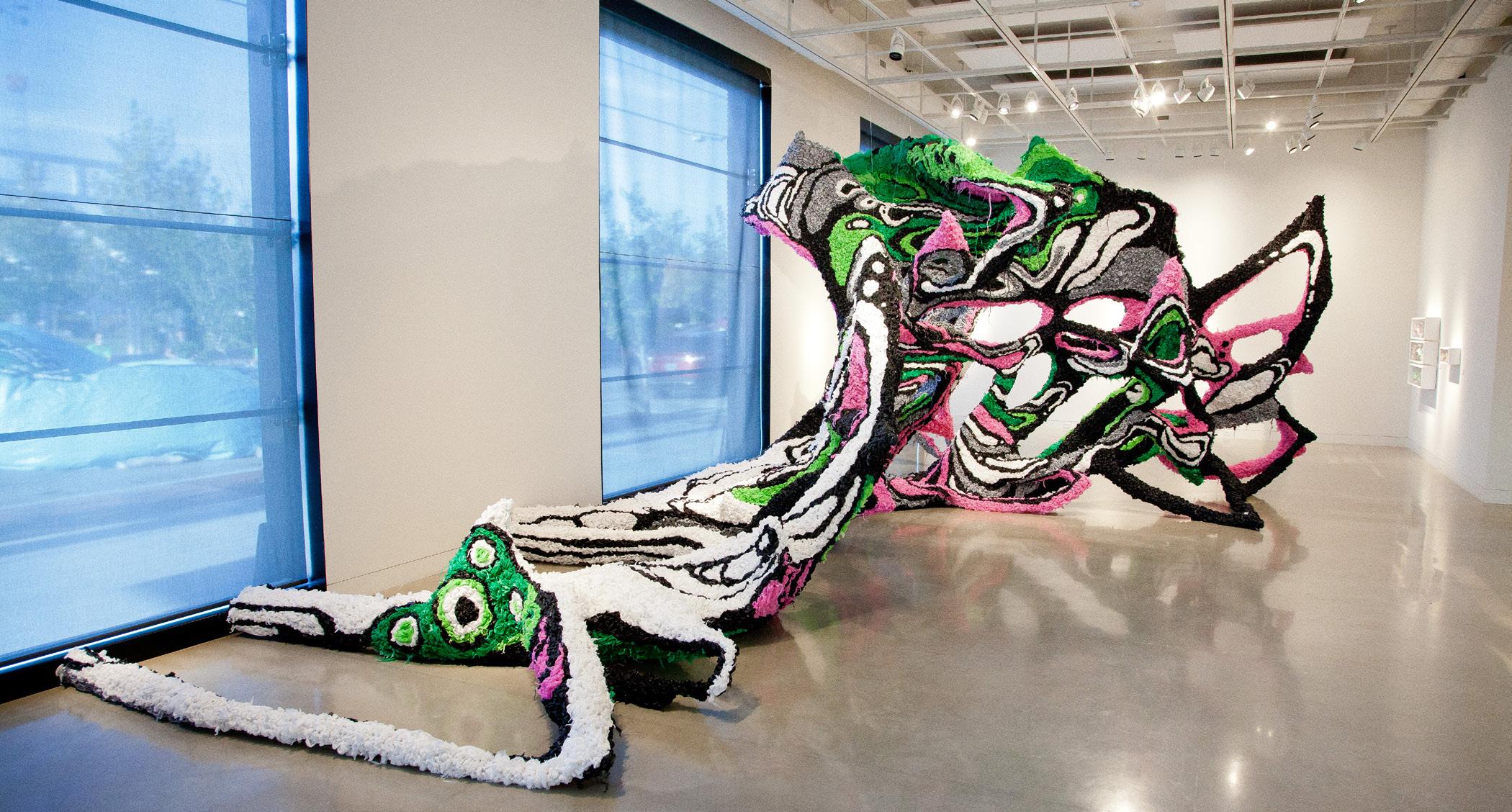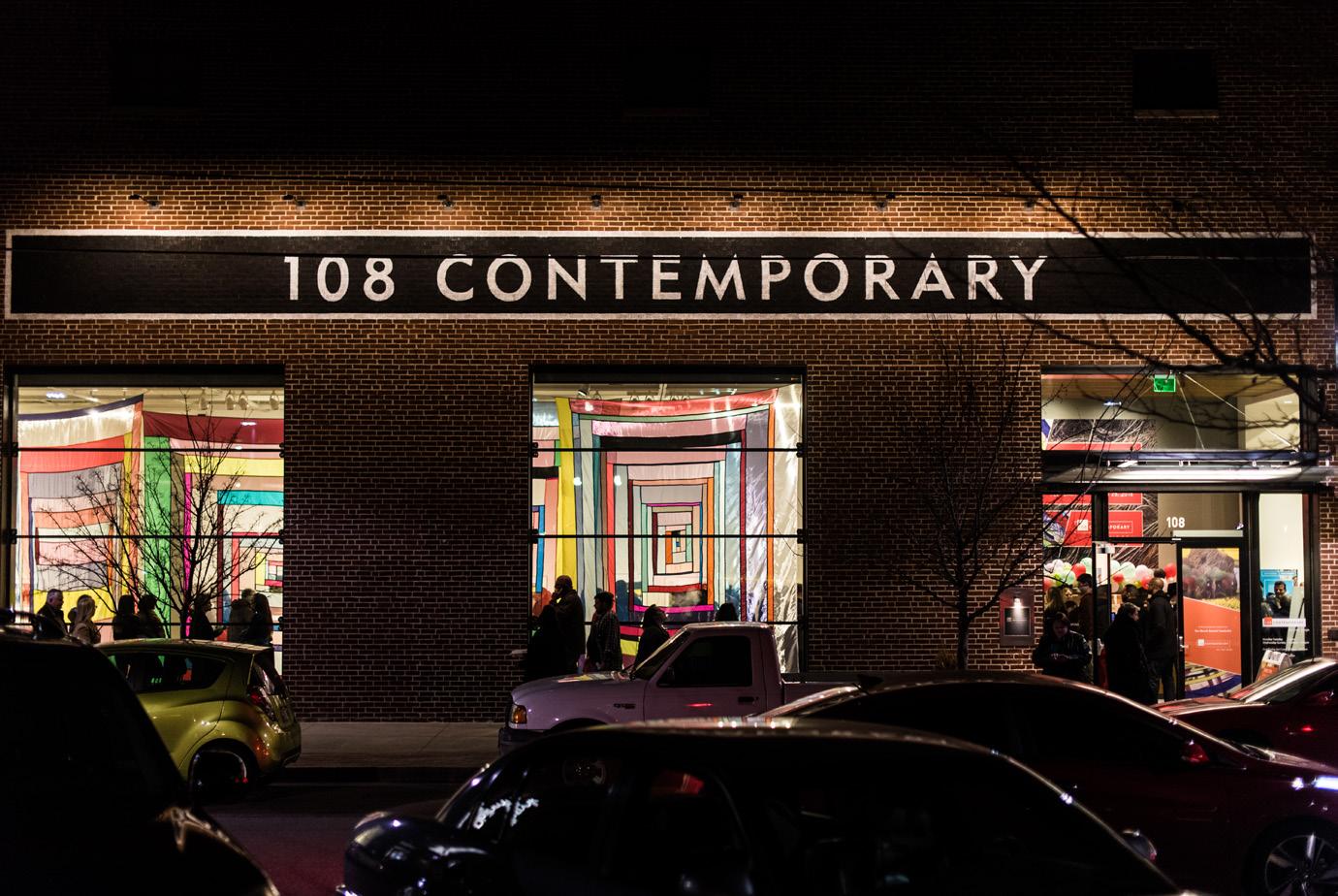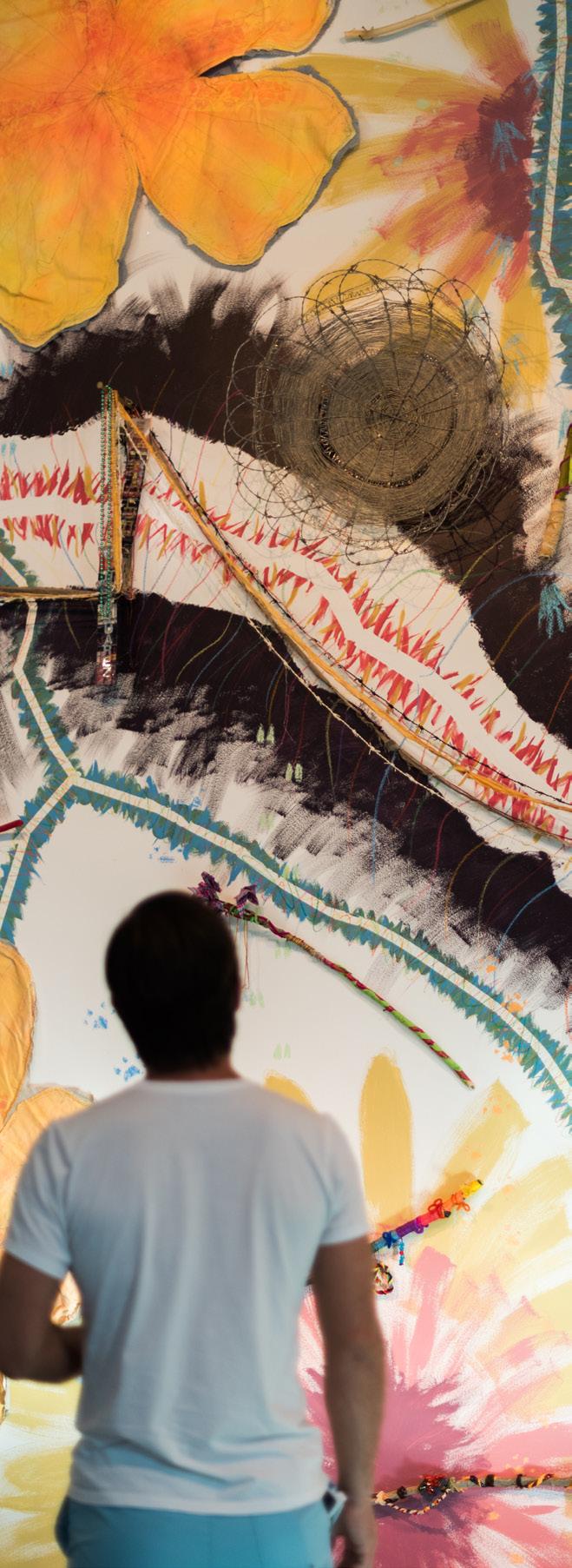VisionMakers2018 is 108|Contemporary’s signature juried biennial exhibition. With an internationally recognized juror and $5,000 in artist awards, it features the work of contemporary fine craft-based artists from a seven state region who bridge cutting-edge concepts with traditional skills as they challenge the boundaries of art, craft and design. 108|Contemporary proudly presents VisionMakers2018 in its architecturally stunning, five-year young Gallery in the historic Mathews Warehouse Building in the Tulsa Arts District.
Special thanks to our generous sponsors.
PRESENTING SPONSOR
Hogan Assessment Systems
SPONSORS
The Judith & Jean Pape Adams Charitable Foundation
Charles and Lynn Schusterman Family Foundation
Peter M. Walter
The Oklahoma Arts Council
Maxine & Jack Zarrow Family Foundation Shannon & Eric Richards
Philbrook Museum of Art
The Oklahoma Arts Council (OAC) initiated the first VisionMakers exhibition in 1988 with cash prizes and significant curators. Subsequent shows held in venues around Oklahoma transformed the public’s view of contemporary fine craft. 108|Contemporary acknowledges OAC as the 30th Anniversary sponsor of VisionMakers2018.
VISIONMAKERS2018 SELECTED ARTISTS
Debbie Barrett-Jones
Contemporary Design Award
Bywater
Identity Award
Genevieve Flynn Craftsmanship Award
Natalie Spicker Art + Craft Dialogue Award
James Thurman Innovation Award
Debbie Barrett-Jones, MO
Emily Blodgott-Panos, KS
Sharon Brush, NM
Rick Bywater, KS
Diane U. Coady, OK
Jane Dunnewold, TX
Holly Fisher, OK
Genevieve Flynn, MO
Whitney Forsyth, OK
Motoko Furuhashi, NM
Dawna Gillespie, TX
Shan Goshorn, OK
Joe Kissinger, OK
Molly Koehn, TX
Beatriz Mayorca, OK
Molly Murphy-Adams, OK
Hannah Oatman, TX
Angel Oloshove, TX
Taylor Painter-Wolfe, OK
Audrey Peck, OK
David Phelps, OK
Chris Ramsay, OK
Erin Rappleye, OK
Sarah T. Roberts, TX
Sandra Sell, AR
Gayle Singer, OK
Jillian Sortore, TX
Laurie Spencer, OK
Natalie Spicker, MO
James Thurman, TX
Ruby Troup, NM
Yulie Urano, MO
Jim Weaver, OK
Emily Zilber, VisionMakers2018 Juror Editor, Metalsmith

At its best, a juried exhibition can capture the breadth, depth, and complexity of a moment in making, bringing disparate voices into illuminating conversation (although not necessarily in harmony). The VisionMakers series adds to that call; we are looking not just at a snapshot of a time, but a region. The submissions for the 2018 edition of VisionMakers make a strong case for the vibrancy of contemporary craft in Oklahoma, Kansas, Missouri, Arkansas, Texas, Colorado, and New Mexico. Each work included in this exhibition embodies an expansive sense of possibility in its marriage of skilled making, intense creativity, and the willingness to simultaneously draw from tradition and break boundaries, where necessary.
It was my great privilege to select the finalists from a diverse selection of submissions. These ran the gamut: sculptural statements ranging from enthusiastic to elegant; functional works for both special occasions and daily practice; adornment that upends our notion of personal decoration; utter abstraction to affecting realism; themes which interpret the past as well as those which speak to an unknown future; and objects of all manner showing the potential of working at the edges of the five traditional fields of craft (wood, clay, fiber and textiles, glass, jewelry and metals). I offer my most sincere thanks to each artist who applied for sharing your abilities, ambition, passion, and dedication to your practice. We benefit from the sharing of your unique voice and perspective with the greater community.
The 44 works chosen for the exhibition display creativity and resolution in equal measure, building a conversation between innovative design and a self-assured approach to making. They relay that sense of ineffable magic which makes a work of art worth visiting over and over again. This aura came through each photographic image, which can handicap even the most engaging and special objects. Together, this exhibition suggests what all who love craft know: our field holds endless promise for those who approach it with invention, skill, and a desire to see it grow. I hope you enjoy spending time with VisionMakers2018 as much as I have.
Debbie Barrett-Jones, MO White Diamonds Handwoven, hand-dyed tencel yarn 47” x 37” x .25”
Textiles artist Debbie Barrett-Jones left her small town in Iowa so she could pursue an education at the Kansas City Art Institute (KCAI) and since graduation has exhibited her work throughout the United States, including the Kansas City area locations, such as Children’s Mercy Hospital in North Kansas City, Truman Medical Center, Community Christian Church and Lead Bank in the Crossroads of Kansas City. Careful consideration goes into color, composition, and material in each of her weavings. Her work reveals the beautiful communication that is the result of one color thread intersecting another. Her panels are comprised of vibrating colors and elegant patterns which create a narrative in flux according to the viewer’s proximity to each piece. Along with weaving large-scale pieces for public and private spaces, she also creates intimate accessories such as scarves, shawls, and necklaces. Sitting at her loom and weaving has become Debbie’s safe place, her sanctuary. Thread by thread, beat by beat of the weaving loom while creating a piece of fabric, provides a meditative experience, which allows her to step away from everyday worries and fears. In the same way, she hopes her artwork inspires peace, hope and contemplation, serving as a beautiful distraction during our busy and chaotic lives. The next step of Barrett-Jones’ studio investigation has the artist digitally recontextualizing her woven objects on metal, paper and fabric. In late 2017 Woven Repeat was launched, which is a new line of home decor, wallpaper, fabric and upholstery, accessories, activewear and more using original woven designs by Debbie Barrett-Jones.

Emily Blodgott-Panos, KS
Sidewalk
Copper, brass, silk, wool, cotton 16.5” x 20.5” x 1”
Using bold color and scale I am trying to create work that reaches the emotions before the intellect. I enjoy using traditional techniques such as raising metal and enameling to both celebrate the history of jewelry and craft and to add my own perspective. In addition, using fabric and fiber with the metal challenges my perception of value and expands both the metal and the fiber’s potential.


I have always been drawn to objects whose history is written upon their surface: the river rock worn smooth from centuries of tumult; the bleached, chewed bone found on the desert floor; the bare-bones landscape of the American southwest. These things speak to me of timelessness and mystery and rouse a thousand questions that will never find an answer. It is all that I don’t know, that deepens my viewing experience. The influence of such objects and landscapes, and my response to them, seeps into every piece I make.
TED ADLER , KANSAS
Untitled Vessel (Concrescence), glazed wood-fired stoneware, 30”x 17”x 17”
Sharon Brush, NM 3 Pointed Vessel Stoneware, slips, terra sigilata 23” x 16” x 8”
I approach the construction of each of my vessels as a sculpture — working to create rhythm, flow, reverberation and quiet within each one. Intrigued by contrasts, I move from slow, sweeping curves to staccato points and ridges; from enclosed space to open passage; from deeply textured surface to riverrock smoothness; from black to white. It is my hope that the finished piece will bring the viewer a sense of calm and quiet.
My pieces are hand-built with stoneware clay, using pinch, coil and slab construction methods. After construction they are sanded smooth, sprayed with layers of slip and terra sigilatta and fired in oxidation to 2200˙.
Clay is interesting to me as both a material and a metaphor. When making, I work to engage a sense of made-ness through the plasticity of the material and the sensuous, fluid volumes of the vessel. The rich, varied surfaces of wood-firing convey the change and flux of the kiln environment. These processes tend to capture the sense of clay’s protean malleability that enhances the way that the objects might be interpreted as a metaphor for the fugitive nature of experience. By using the vessel as an analogy for selfhood and subjecting it to processes of forming and firing that lend themselves to a sense of transformation (which is both actual and figural), I hope to elicit a sense that our relationship to ourselves and the world around us is more slippery than we ordinarily like to admit.
tedadlerceramics.com

Rick Bywater, KS
Twelve Point Star
Sycamore wood, India ink, pyrography 19” x 19” x 1.5”
As a wood turning sculptural artist, the lathe is the starting point for my work with embellishing, carving, coloring, pyrography or painting. I see my craft evolve into art. After a 28-year career in industrial real estate and living in Kansas, I went from a weekend hobbyist to a self taught sculptural wood artist. Having lived on the Navajo Indian reservation as a kid and growing up later in Oregon ingrained an appreciation for nature and the outdoors. I am always looking for creative ideas and find it in nature’s shapes, colors, textures and patterns. Being drawn to the line of the curve which becomes the form is the essence of my work. I have focused the last two years on wooden basketry, using epoxy and controlled green wood drying techniques.



Diane U. Coady, OK Weather or Not Silk dye, silk organza, oil, canvas, adhesive 24” x 24” x 1.5”
Dye work on silk is a multistep process that begins with flat white silk and application of pigments. Creating texture on silk is a manipulative process and one method is pleating fabric randomly in a Japanese technique known as arashi (storm) shibori.
Weather or Not tells the story of the tempestuous nature of spring. As a resident of Oklahoma I have been both alarmed and relieved by its changing behavior, often in the same hour. A blue sky may turn a blackish green with whipping winds causing houses to fly. Or it may all dissipate into sunny laughter. By painting vulnerable houses in oil on canvas then overlaying with painted and dyed manipulated silk, I endeavor to relate the chaos one may see and experience.


 Jane Dunnewold, TX
Jane Dunnewold, TX
Messengers
Vintage quilt blocks, Bible and dictionary pages, spackling, gold leaf, pigment 40” x 67”
These works further my interest in re-purposing vintage quilt blocks. I like the idea of using old pieced blocks that some other woman made, but never finished as a quilt. It’s an opportunity to complete an untold story, while tracing the literal thread back through generations of unsung women makers. The process of making is my meditation. Over several decades of working I’ve assembled an active visual language, which I continue to expand. The geometry of the quilt blocks is an inherent part of my language, as is the use of circular images, gold leaf, and plaster/spackling. A completed piece is a prayer of thanks offered to the Universe.



Holly Fisher, OK Bouys For Big Change Steel, patina 22” x 10” x 22”
My current work involves creating metaphysical tools for better living. I make imaginary instruments which assist humans in successfully completing cognitive tasks. Tasks such as coping, forgiving, deciding – actions which, when emotionally based, can commonly make life complicated. My sculptures are fantastical implements designed and built to help humans sort through conflicted feelings, cope with anxiety, demolish guilt, extinguish shame and squelch remorse – the works are handy devices to aid people in achieving peace and tranquility.
I am a metal sculptor. I am a blacksmith. I most often employ traditional blacksmithing processes to create my work, but I am not afraid to employ current technologies to achieve a desired result. Metals are magical and the processes used to form them I find quite exciting and rewarding. Metal objects possess a multifaceted familiarity to humans, they are tangible markers of time – souvenirs of existence.
My work at its core is intended to reflect and provoke thought – to start conversations and promote connection. My sculptures provide platforms for thoughts to be thought about, recognized, validated, processed and shared. In a perfect world, my work would provide a means for others to discover their truths and share them. In a broad view, I hope to make the world a better place by promoting commonalities and enhancing understanding.
Inspirations include:
Alfred Bullermann’s community inspired metal sculptures; Dialectical Behavior Therapy; Gabriel Garcia Marquez’s magical realism; Rube Goldberg’s contraptions; Scott Lankton’s forged steel and bronze works; mental health; metacognition; The Oklahoma industrial landscape; Sesame Street 1975 – 1982; Kurt Vonnegut.



Genevieve Flynn, MO Golden Botrus
Sterling silver, 23 ½ karat gold leaf, Pau Rosewood
4.5” x 4” x 4.5”
Ssssssumptuous Teapot
Sterling silver, 24 karat yellow gold plating
8” x 5” x 3”
Using nature as my inspiration, I endeavor to create expertly crafted heirloom hollowware and vessels. The fluid lines and sensuous feel of the Art Nouveau era along with the beauty of nature is reflected in my work.
I fabricate all of my work, which means I do not use any manufactured items. Each piece is cut and shaped from sheets of metal. Silversmith techniques are used to form the metal into three-dimensional forms, which make my pieces come alive. Ancient metal techniques such as chasing, repoussé, granulation (a process that fuses gold to silver), saw piercing and many others are incorporated to add detail, interest and beauty.




Forsyth, OK
Moment Brick clay 8” x
The mandala is a symbol of wholeness that is found in cultures around the world. The symbolic diagrams reflect the symmetry of natural forms, the cycle of life and the circle of community. From ancient Hindu mandalas to Native American sand paintings, Celtic knotwork and Christian rose windows, they promote spiritual health and well-being. Forsyth’s mandalas represent her life journey, telling a story of where she has been and where she is going.
Forsyth recently returned from a residency at Watershed Center for Ceramic Art. This work represents many of the new ideas that evolved in her work as a result of the amazing experience.


Motoko Furuhashi, NM
Black Mountain Tape, brass, silver, powder coat 6.7” x 2” x 2.75”
I am fascinated by the natural cycle of growth, decay, and death – and the complexity of the processes that govern life between one place and the next. Using specific sites as my medium, I expand the conceptual meaning and purpose of the object, and play with the audience’s understanding of place. Relevant to the site from which materials have been excavated, each object is a representation of the specific correlations between time, location, perception, and importance; each carrying the history of the site captured within. My jewelry objects are distant memories embodied, and histories waiting to be told.

Dawna Gillespie, TX Textured Soul
Copper, wire, velvet ribbon, brass washers
15.5” x 8” x .75”
When surveying society around us, there is a realization of the excessive need in identical and mass-produced adornments. This impulse is bizarre and foreign to my soul; it causes an intense overwhelming feeling of disconnection, both aesthetically and emotionally, between the masses and myself. Transcending the allure of simply adorning the body, my artwork consciously explores the illumination of personal presentation and facilitates an individual expression. Through the intensity of the colors and texture, significance of the size of each piece, and the rarity of the piece itself, I am able to work through the disconnection I feel towards society and inevitably nourish my soul.
My hand fabricated, soulful, and never-reproduced adornments begin as flat sheets of raw copper and brass, and take shape using a jeweler’s saw. Fabrication of each piece takes 30-80+ hours; the result is a lightweight wearable artwork that is truly distinctive. My collections are the culmination of my soul’s stories. Textures found in every piece represent the “emotional scars” on my soul; translated through patina, oxidation, hand etching, or hammering. The layering of motifs and shapes that I design are then manipulated and sawn to symbolize various aspects of my life: my marriage, our child, decisions I have made, or feelings I have.
As a metalsmith, I channel the very essence of who I am by the means of fabricating raw materials into intimate pieces that truly “connect” with the wearer. I believe every time a person places a piece of my art on their body, or even in their home, our souls are forever joined through the energies of shared space and time. With an unwavering purpose to restore and reconnect: individuality, reverence to craftsmanship, and the world’s intrinsic beauty; I am connecting never-reproduced adornments and beautiful souls together – one at a time.



Shan Goshorn, OK
A Basket Full of Light
Arches watercolor paper splints printed with archival inks, acrylic paint, artificial sinew, silver and copper foil 10” x 6.25” x 6.25”
Although my career was initially launched in the mid 1980’s with hand-colored black and white photographs, I don’t consider myself a photographer. I think of myself as an artist who chooses a medium as a tool for the best possible way to express a statement. Recently, I have found myself drawn to the traditional crafts of my people, Eastern Band Cherokee, specifically basket making, as a way to illustrate my political statements and bring awareness to contemporary native issues. Combining reproductions of historical documents and photographs with contemporary ones, and weaving them together using traditional techniques and patterns, I strive to educate an audience about some of the unique issues that continue to impact Indian people, i.e. tribal sovereignty, gaming, repatriation, treaty violation, the commercial use of our images and names (mascots, etc), denial of religious freedom and the highest rate of substance/alcohol-related suicide.
It is my belief that much of the “dis-ease” and struggles of Indian people are a result of America’s policy regarding the first peoples. Whether it is from the attempts to erase all Native identity by denying Indian children their language and culture through boarding schools assimilation, breaking ties among tribal support through Indian relocation acts, providing Indian people with commodity food that have contributed to major illnesses, etc., historical trauma continues to plague us in a big way. It is my goal to enlighten audiences to these ongoing practices and encourage honest dialogue between people. I believe it is only through mutual understanding and respect that we can move forward and heal the wounds created by these repeated violations of our human rights.

Most of my wood pieces begin as a shape or group of shapes that I create on a wood turning lathe. While some pieces begin by cutting apart and reconnecting the sections into a new form, other pieces are turned to match a particular objective. I then add different surface embellishments like acrylic or metal reactive paints and dyes, bleaching, burning and ebonizing effects and the use of copper, brass, leather or other fibers to produce the shape and colors of the final object. Each different piece of wood brings its own character and the possibility to find something new, unexpected and unique.
Joe Kissinger, OK
All the Pieces
Bleached and ebonized ash, lacquer 9” x 8” x 8”

Molly Koehn, TX Structure 13
Handwoven stainless steel, linen, silk, wood, piano wire, spray paint, washi tape 36” x 4” x 4” $550
Landscaping practices point to our idealization of nature, curating land to be what we find attractive. I respond through material and construction to city landscaping and structure and my own impulse to plant a palm tree, exploring why we choose to seemingly improve the aesthetic appearance of our surroundings by often eradicating the “natural” in preference of the artificial. I weave as a response to this built environment. The grid provides essential architecture to both the city and woven cloth. Through observation of the gridded streets and buildings constructed of steel and concrete, I utilize the same materials to create responsive sculptures that present an opposing narrative to that of the solid and stable architecture. These works offer parallels between natural and synthetic, stable and decrepit, strength and fragility and embrace the temporal qualities of our fabricated environments.



Beatriz Mayorca, OK Roots Chair
Polished concrete, powder-coated steel, glass mosaic tiles 36” x 23.25” x 31.5”
Cata Lounge Chair
Stained-laminated plywood and clear powder-coated steel
As a fine artist, interior designer and maker, my artworks move between sculptures and functional artistic pieces — which focus on a modern and contemporary mood, but also, influences from cultures around the world. This is reached by combining the warm feeling of wood, with the coldness of industrial media, like concrete and metal, and a splash of alternative materials. My constant sketches and creations are the result of an intensive and calculative process. Their conception took place in the application of architectural and design elements, based on the essence of geometric figures, which brings about memories of pleasant moments and playful sensations.
As a fine artist, I have been developing three collections. ‘The Playfulness Collection,’ is where bright colors, playful concepts, and designs are complemented by the use of metal and concrete as the main material. ‘The Lines Collection,’ which uses, as the main procedure, the plywood lamination and bending techniques with the intention to explore and challenge its boundaries through diverse three dimensional expressions, but always with the aim to captivate the viewer by the repetition of the veneer’s lines depicted. And the ‘Latin Collection’ where I use more traditional forms and concepts which inadvertently tethers me to my cultural roots.




Molly Murphy-Adams, OK
Fixate
Beadwork on silk 10” x 10” x 1”
Murphy-Adams’ work illustrates the blending of culture, identity, and histories. Murphy freely borrows from multiple disciplines to create fiber and mixed media arts pieces reflecting her diverse background and traditions.
My work serves is a cultural narrative, an expression of personal experience, and an exploration of form and function. I choose to use specific materials and designs as a way to connect with tribal art forms from antiquity while embracing the reality of my mixed heritage, Descendant of Oglala Lakota. My designs originate from older, more traditional sources while material choices reflect the effect trade goods had on aesthetic and fashion. These physical elements create a specific textural and tactile experience necessary to tell my stories. The liberties I take with materials, line quality, and design elements reflect my interest in contemporary art and the development of abstraction in the Western art tradition. I use the visual language of color and shape to articulate new observations on politics, history, and identity.


Hannah Oatman, TX
Collage 04
Steel, sterling silver, vitreous enamel, 18k gold
6” x 4” x .75”
Collage 12
Copper, steel, sterling silver, vitreous enamel, 18k gold 3.5” x 2” x .5”
In this series, intensely saturated planes play off of each other, allowing separate hues to reverberate and dematerialize into a field of color. Spontaneous forms and carefully arranged layers invite the viewer to explore the surface before investigating supporting armatures. The enameled elements, while seemingly coarse, provoke a sense of preciousness. The resulting collages are playful and curious, urging the viewer to handle and consider them as objects first, and then as engaging adornment.




Angel Oloshove, TX Beyond the Next Bardo Ceramic, glaze
9” x 6” x 5”
In 2006, I moved to Tokyo after making my way through the rigorous painting program at the California College of Arts and Crafts. I found myself in a new country, new culture, new language all of which was foreign to my rural Michigan upbringing. Walking through the city I was lost in abstraction searching through the symbols for clues and meaning. The temple rituals had a language of their own. Thousand-year-old Buddha effigies in forests, the details worn away by years of life, of being adored, are revered and imbued with energetic prayers of the faithful.
I found myself disoriented, but I was able to open up to what was being communicated to me. I felt like a girl again lying in tall fields of wheat at sunset where all visual perspective was lost. Pulling apart stray leaves as I listened and observed. Nature has a language; the city had a language. The energy was there if I could take pause and receive it.
Here I found my home in abstraction. I understood the importance of objects, creating sentient entities to reckon with in our physical reality. Clay came to me as a way to connect the ephemeral with the physical world. The work had to take up space in reality in three-dimensions.
I work only in clay. I’m attracted to the alchemy of the medium. I’m interested in using glazes, luster in new ways. I like to limit my palette of materials to things within the ceramic practice. I explore color in glaze, luster and experiment with multiple techniques for building my work.

Taylor Painter-Wolfe, OK Dragon’s Backbone Handmade, hand-dyed felted wool and thread 65” x 55”
My work is made entirely of felted wool I make and dye by hand. Making my own materials is an important part of my artistic process because it allows me to have a hand in every aspect of creating my art from start to finish. The unpredictability involved always yields unique and interesting results. Oftentimes holes, irregular edges and sizes, and interesting variations in color and texture occur. I never get the same shape or color twice, making each piece unique. I use the material and its imperfections to inspire me and guide my decision-making process about the art I create with it. Using traditional fiber art techniques such as felting, dyeing, and stitching, I turn what was once just plain white wool into colorful and dynamic abstract landscapes.
My inspiration comes from aerial photography, satellite images, and textures and shapes found in natural environments. From high above, the details of a place are stripped away leaving only an elegant design of intersecting, shapes, colors, and lines. I look at thousands of miles of land and turn it into mere inches of stitched felt, providing a unique overview of an expansive space that cannot adequately be seen and understood from the ground. I am particularly interested in representing landscapes where natural and man-made environments intersect and have a compelling influence on each other. I often use as inspiration, areas affected by climate change, natural disasters, and human use. My intent is to create a simplified and thoughtprovoking way to view land, our impact on it, and relationship to it while leaving the work open to interpretation, putting no demands on the viewer to see one particular type of landscape over another.

Audrey Peck, OK Creek
Shale, reclaimed wood, sterling silver
3.25” x 2.25” x .25”
Counting Days
Shale, reclaimed wood, sterling silver 3” x 1.75” x .5”
My work is a reflection of my surroundings. My childhood was filled with long afternoons spent playing outside and summers camping with my family, activities that cultivated in me a reverence for the natural world and its power to calm my active adolescent mind. As an adult, I find myself spending less time outdoors, with diminishing opportunities to experience the nature that is essential to my well-being. So, I make outdoor adventures for myself, and like a child bring little bits home with me: rocks, pieces of wood, etc. — these humble treasures become icons in my wearable pieces. My work also explores the tension in the edges of our environment, where man-made structures and Mother Nature overlap. With metals and mementos, I’m proposing a balance, where natural forces and the ethics of our built world can sustain each other through a mutual determination to thrive.
The materials I choose – both natural elements and pieces that I collect from deteriorating built structures — attract me with their evidence of time passing. My use of wood is a form of recycling, crafting memento mori out of nature’s bones. In our ever-updating lifestyle that includes fewer quiet moments to enjoy nature and more hours stifled by technology, making and sharing this work is a respite for me, a space to breathe.



David Phelps, OK Team Lauson
Found objects, cast bronze, plastic, teak 25” x 40” x 19”
My work, largely auto-biographical in nature, explores the relationship between figure and environment. My early work dealt with an implied environment beyond the sculpted image. This is still true in pieces such as Drifting. In addition to this approach, in more recent works, I also utilize fabricated materials to define and narrow the relationship between figure and environment. Works such as Team Lauson continue my exploration of personal history, but with a different approach. These pieces represent significant objects from my personal history in a way that brings life to these memories. 2017 Watch is an example of a work that combines my personal history with my reactions to current events.
I was raised on a farm on Roberts Island in the California Delta. My figurative imagery has developed from these early experiences on the farm. Flood, drought, solitude, and an expansive environment have all played a significant role in my aesthetic development. How deeply those experiences are ingrained in my subconscious becomes apparent when I consider that almost every dream involves the farm in some way. I try to connect with people through my artwork in an indirect way, much like waving to distant passing cars from the solitude of a tractor seat.
Two prominent memories from the farm are a skull that resided in “the shop” and a salt fired Amsterdam Gin Bottle from the 1800’s that hung out in Grandma & Grandpa’s dining room. Grandfather Lloyd L Phelps Sr. (1911-1994) bought property throughout his life as a farmer. He bought unleveled acreages which could only be dry farmed. As he was able to, he leveled parcels of land so that it could be irrigated. Eventually all the property was level and irrigated. An abandoned privy site was uncovered during one of the levelings. In the 1800’s it was common to toss all sorts of trash in the hole when a privy had to be relocated. This particular site contained a pristine salt fired Amsterdam gin bottle which my grandparents held on to.



Chris Ramsay, OK
Sustainable Wood, carbon, found objects, brass, glass
30” x 40” x 6”
Unsustainable Wood, carbon, found objects, brass, glass
30” x 40” x 6”
Sustainable / Unsustainable. The form and content of this work is informed by an Artist-in-Residency at Crater Lake National Park where I focused on observing the effects of climate change upon the park habitat. Evidence of global warming was not difficult to discover as the largest fire in recorded park history took place during my visit resulting from extreme drought conditions.
In Eric Roston’s 2008 book, The Carbon Age, he explains that the earth cycles carbon over 350-400 million-years which led me to visualize the earth as a living-breathing life force that could sustainably balance the carbon cycle. However, one primary problem of climate change today is that we humans are reintroducing (by excavating and burning) ancient forest carbon and removing contemporary forests (that extract carbon-dioxide and produce oxygen) at an alarming rate that is creating an unsustainable presence of carbon-based emissions that trap heat within our planet’s atmosphere, producing a litany of growing disastrous side effects that threaten our very existence on this planet.




Erin Rappleye, OK
Reliquary for Performance Objects
Wood, found frames, laser cut and etched acrylic, hand-cut brass with patina, LED, brass finding, paint 30” x 16” x 5”
Reliquary Objects
Hand-cut brass with patina, laser cut and etched acrylic, garnet, labradorite, rutilated quartz, pearls, fabric, lipstick, dried milk // Hand-cut brass with patina, laser cut/etched acrylic, vitreous enamel, silver // Silver, copper, used gold dental fillings, rutilated quartz, pearls, labradorite, pink moonstone 5” x 5” x 2” each
Storytelling serves as a way of connecting with others emotionally through a variety of experiences. I create characters and objects that are part of a larger context exhibited in an installation environment. The objects I create are not wearer neutral, they implicate the wearer; for example, a liar’s mask or a horse’s bit, submits the wearer directly into the role of the character. The wearer then becomes part of the story, activating an immersive environment for both the performer and the viewer. The stories expressed through my installations explore sexuality, partnership, femininity, behavior, communication, and misunderstandings.
I am interested in jewelry’s ability to serve as a vehicle for revealing narratives. The broadest objective of jewelry as an art form is to impact or complement the story of the human body. It is an objective informed by inherent material value and psychological/emotional value. The latter determined by relationships, interaction, personal history, legacy, and gesture which I explore through performance. I believe positive and negative environments have the ability to manipulate our perception of ourselves just like something physically attached to us. My research centers on how body adornment can reflect personal psychology as influenced by a given environment and the potential for the objects within that space to respond as witnesses to further illustrate stories within an installation.


The development of my artwork centers on an early trauma of loss, its subsequent effects on my identity, and the pleasurable, habitual behavior to control objects. Inspired by intimate feminine forms connected to my childhood, I re-interpret patterns of lace or clusters of flowers into fragmented, melancholic and sometimes menacing faces. This repetitive manipulation of the “fetishistic” object examines what lies within and between the boundaries of protection and threat, subject and object, and isolation and intimacy.
Sarah T. Roberts, TX
Phantasm I
Powder-coated aluminum 14” x 12” x 12”
Counter(balance) Steel, patina 12” x 8” x 8”



